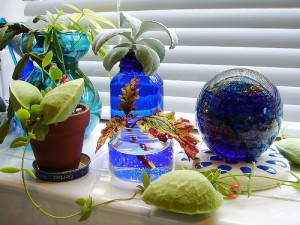Green Greens – How to keep your house plants looking fresher for longer
November 27th, 2009 by adminHouseplants are a great addition to any home. As well as serving to beautify your interior, houseplants provide oxygen and help to clean the air. Specially selected plants are even used in orbiting spacecraft because of their beneficial air purifying properties. However, keeping houseplants healthy and fresh can be a troublesome task. That’s why we’ve listed a top number of tips to help you keep your greens green and hassle-free.
 The first step is to select the correct plants for your climate region and your specific home.
The first step is to select the correct plants for your climate region and your specific home.
Plants are fascinating life forms. They utilize photosynthesis to create organic compounds from carbon dioxide, unlike animals that need to consume other living organisms to produce energy in order to survive. However, plants use light as their energy, to transport water up through their stems and extract minerals from the soil using their roots.
Different plants need different levels of light. Choose low light plants for areas that are far away from the window, or suffer from a particularly dark seasonal climate. You can use shadows to measure the strength of light in a particular area. For example, if the shadow of the plant is hard to detect, then the light in that area is low. If the shadow is detectable but not sharp, then light is medium strength. If the shadow is sharp, then light is bright and plentiful.
Think about using sheer curtains to increase the amount of light entering the room. However, you should be careful about placing plants between a curtain and a window during cold weather spells, especially if the plant species is not very tolerant of low temperatures.
Plants tend to bend towards the direction of light, ao make sure you turn the plants regularly to keep them growing in an attractive shape. Note that some plants do not tolerate excessive sunlight, so it pays to do your research before ordering.
Plants that come from rainforest environments are often the easiest to grow indoors because they are adapted to living under a canopy with limited sunlight. Such plants include the Ficus, Cheese Plants, Rubber Tree Plants, Dracaeana and Begonias. However, these plants are also adapted to plenty of moisture as they come from the Rain Forest, so they will need frequent watering.
As many houseplants are tropical species, they tend to like humidity. They also prefer warm environments. However, generally humidity is more important than temperature, so you will need to take this into consideration when thinking about the right environment for your plants.
If your houseplants are losing leaves or yellowing, then lack of humidity may be the cause. Heated rooms tend to be dry, although steam and water heaters are less drying than air heaters. The correct humidity for most houseplants ranges between 50 to 70 per cent. To raise the humidity in a room, increase the number of plants you have (each plant generates humidity of its own). Placing jars of water in the room will also work, or you can set plants in a tray full of wet gravel. Misting plants regularly is also beneficial (unless they have fuzzy leaves). You should mist at least once a day, and for many plants several times a day is better. And, if you’ve got the cash to flash, purchasing a humidifier that pumps water vapour into the air may be the answer.
Never allow temperatures to dip below 50 degrees F, as most houseplants are not adapted to cold weather. Also remember that windows tend to be colder than other areas of the room because of poorer insulation. You might want to consider double glazed windows for their extra insulation.
Soil is another important element in keeping houseplants healthy. Make sure you use fresh soil and only use fertilizers that are specifically made for houseplants. Use fertilizers only during the spring and summer, a bit in the autumn, but not in the winter. You can also groom plants by trimming off withering parts, or faded flowers to keep them in good-looking shape, and encourage re-growth.
Keeping your houseplants fresh is fairly simple once you have taken time to learn about specific types, and have started a regular routine. The benefits however, both aesthetic and health-related, are well worth the effort!
You may also like
On November 18th, 2022 Colin wrote on the subject of Company News and Press Releases.
Get the Look: Pantone Colour of the Year 2021
On January 22nd, 2021 Debbie wrote on the subject of Colour schemes, Industry News, Interiors and Ideas.
Forget Feature Walls, What About a Statement Ceiling?
On April 3rd, 2018 Debbie wrote on the subject of Fun Stuff, Interiors and Ideas.





 0
0